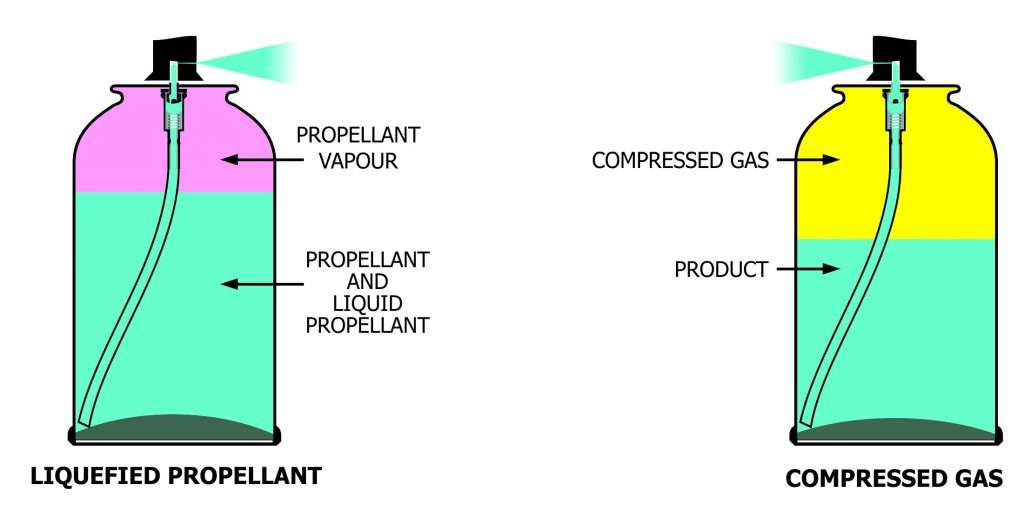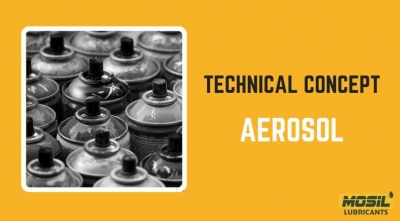WHAT ARE AEROSOLS
Aerosol spray is a type of gaseous suspension system which creates a gaseous mist of liquid molecules. This dispenser changes the ingredient inside the container into an aerosol where liquid molecules widely and evenly dispersed throughout a gas. Aerosol is filled in a can which contain propellant and specific solvent under pressure. The mixture is enforced out from container through a small opening present at the top which is under higher pressure, when the container’s valve is opened. As a result of higher pressure inside the can and sudden pressure release, a aerosol mist is formed.
ROAD OF EVOLUTION OF AEROSOLS
1790 : Self- Pressurized carbonated beverage introduced in france
1943 : Department Of Agriculture researchers Goodhue & Sullivan develop a small aerosol can pressurized by a liquefied gas in USA
1949 : The first one inch aerosol valve is introduced.
1953 : Aerosol industry quickly developed in United States and around the world
COMPONENTS OF AEROSOLS
An aerosol canister is actually a complex piece of machinery that helps deliver a steady, concentrated stream of whatever product that is filled inside the tin which is encompassed of following components
• Propellant
• Product concentrate
• Aerosol container
• Valve and actuator
Propellant:
Propellants are responsible for intensifying the pressure in the aerosol container and when the valve is opened it ejects the product from the container and helps in expels the product by atomization of contents or foam production of the product.
Types of Propellants:
• Liquefied gas propellants
• Compressed gas propellants

When liquefied gas is used as propellant, under pressure propellant exist in liquid and at head space, it exist as gas. When valve of container is opened, some of the liquid propellant turns to gas but pressure remains unchanged as time passes. Liquid propellant helps in blending the dissolvable solvent with it completely. For example LPG, CFC etc
Liquefied Petroleum Gas: which is also known as autogas is a blend of Propane, Butane and n-butane which are natural compound. By the blend of these substances as to their distinctive physical-chemical parameters, it is easy to accomplish the required pressure inside the aerosol canister and environmentally safe because these compounds break down in the atmosphere at a quicker rate than the CFCs bringing about a lower ozone-depleting impact.
Features of LPG:
• LPG has fundamentally bring down cost when contrasted with different fuels, for example, Dimethylether (DME) and Chlorofluorocarbons etc.
• LPG is a steady and pure propellant compound.
• LPG is an odourless, non-corrosive and non-toxic gas.
• LPG offers an extensive variety of appropriate vapor pressure and boiling points.
The impediment of Hydrocarbon propellants are flammability and explosive. So the use is lessened propellant.
Chloro Fluro Carbon: which is known as Freon are completely halogenated paraffin hydrocarbons that contain just carbon (С), chlorine (Cl), and fluorine (F), produced as volatile derivative of methane, ethane, and propane. CFCs and HCFCs are colorless, volatile, poisonous fluids and gases with a faintly sweet ethereal odor. Overexposure at concentrations of 11% or more may cause dazedness, loss of concentration, focal nervous
system depression and causes the exhaustion of ozone layer.
Compressed gas propellant:
Compacted gas fuels occupy the head space over the fluid in the tin. When the aerosol valve is opened the gas drives the fluid out of the can. In the head space the amount of gas stays constant which on usage pressure decreases because most of the gas escapes the can. For example Carbon dioxide, Nitrous oxide and Nitrogen.
Carbon dioxide: It has high vapor pressure which is less toxic compared to hydrocarbon propellants. Since because of low cost, it is mostly used in most of aerosol sprays which is normally used in a concentration of 2-4%. While preparation of Carbon dioxide propellant, oftenly CO2 from air is used by fractional distillation and it does not add extra carbon dioxide to atmosphere. Because of their low expansion ratio, the sprays are rather wet and the froths are not as steady as created by liquefied gas propellents.
Nitrogen: An ideal propellant which helps in keeping up flow of the most viscous fluid through any continer. It also eliminates oxygen and carbon dioxide from container completely reducing the possibility of fire catch or acid formation incase of flammable solvents. Since it is of very high cost and is high pressure with low solvency in numerous solvents, it is normally not used in aerosol spray.
Nitrous Oxide: At room temperature, Laughing gas is a colorless non-flammable gas, which is mainly approved to use for food grade product and it is higHly soluble in most of the solvents. When pressure inside the canister is released, the liquid nitrous instantly turns to gas, expanding the volume to 4 times than that of the solvents.
AEROSOL CONTAINER:
Aerosol container more oftenly is a metal can or plastic container, intended to apportion its fluid substance as mist or fog. The determination of the container for a specific aerosol product depends on its versatility to production techniques, ability to manage the pressure essential for the item and compatibility to solvent and the cost etc.
Usually aerosol spray container are primarily made up of metal, glass, plastics depend on behavior and characteristic of solvent and propellant used.
Types of container:
• Unlined Metal Containers: It is mainly used for solvent based aerosol and used for water based
concentrates which contain corrosion inhibitor.
• Double Lined Metal containers: This can be used for Water Based Aerosols where added corrosion protection is required. Interior coatings are made up of – phenolic resin, urethane, or epoxy which are normally applied before container fabrication.
• Lined Metal containers: This can be used mainly for a water-based application. Solvents will usually dissolve lining in them. If water-based formulation contains more than 19% of Dimethyl Ether then use Unlined Can with good corrosion inhibitor package. Dimethyl Ether at this level will penetrate the can lining allowing attack of tin plate. Some of the two-piece containers only come lined, therefore stability must run for the solvent blends.

